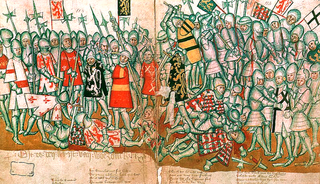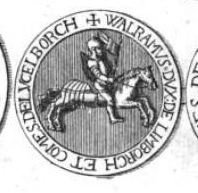
Year 19 was a common year starting on Saturday of the Julian calendar.

Limbourg or Limbourg-sur-Vesdre is a city and municipality of Wallonia located in the province of Liège, Belgium.

The Battle of Worringen was fought on 5 June 1288 near the town of Worringen, which is now part of Chorweiler, the northernmost borough (Stadtbezirk) of Cologne. It was the decisive battle of the War of the Limburg Succession, fought for the possession of the Duchy of Limburg between on one side the Archbishop Siegfried II of Cologne and Count Henry VI of Luxembourg, and on the other side, Duke John I of Brabant.

The Duchy of Limburg or Limbourg was an imperial estate of the Holy Roman Empire. Much of the area of the duchy is today located within Liège Province of Belgium, with a small portion in the municipality of Voeren, an exclave of the neighbouring Limburg Province. Its chief town was Limbourg-sur-Vesdre, in today's Liège Province.

The County of Loon was a county in the Holy Roman Empire, which corresponded approximately with the modern Belgian province of Limburg. It was named after the original seat of its count, Loon, which is today called Borgloon. During the middle ages the counts moved their court to a more central position in Kuringen, which today forms part of Hasselt, capital of the province.

Godfrey I, called the Bearded, the Courageous, or the Great, was the Landgrave of Brabant, Count of Brussels and Leuven (Louvain) from 1095 to his death and Duke of Lower Lorraine from 1106 to 1129. He was also Margrave of Antwerp from 1106 to his death.

The House of Luxembourg or Luxembourg dynasty was a royal family of the Holy Roman Empire in the Late Middle Ages, whose members between 1308 and 1437 ruled as kings of Germany and Holy Roman emperors as well as kings of Bohemia, Hungary and Croatia. Their rule was twice interrupted by the rival House of Wittelsbach. The family takes its name from its ancestral county of Luxembourg which they continued to hold.
Frederick of Luxembourg was a younger son of Frederick, Lord of Gleiberg.

Henry I was the count of Limburg and Arlon from 1082 to his death and duke of Lower Lorraine between 1101 and 1106. His mother was Jutta, daughter of Frederick, Duke of Lower Lorraine, and his father is uncertain, but possibly named Count Udon.

Waleran II, also called Paganus, probably due to a late baptism, was the Duke of Limburg and Count of Arlon from his father's death in about 1119 until his own twenty years later. He was given the Duchy of Lower Lorraine by Lothair III, Holy Roman Emperor in 1128 after the latter's accession as King of Germany in 1125.
Henry II was the duke of Limburg from 1139 and count of Arlon from 1147 to his death. He was the son of Waleran, Duke of Lower Lorraine, and Jutta of Guelders, daughter of Gerard I of Guelders. He succeeded his father in Limburg with the title of duke, but Conrad III refused to grant him Lower Lorraine. He continued to style himself as duke nevertheless.

Waleran III was initially lord of Montjoie, then count of Luxembourg from 1214. He became count of Arlon and duke of Limburg on his father's death in 1221. He was the son of Henry III of Limburg and Sophia of Saarbrücken.

Henry IV was the duke of Limburg and count of Berg from 1226 to his death. He was the son of Waleran III, count of Luxembourg and duke of Limburg, and Cunigunda, daughter of Frederick I, Duke of Lorraine.
Waleran, Galeran, or Walram is a Germanic first name, common in the Middle Ages, that may refer to:

Henry V the Blondell, called the Great, was the Count of Arlon from 1226 to his death, lord of Ligny from 1240 to his death, Count of Luxembourg and Laroche from 1247 to his death, and the Marquis of Namur between 1256 and 1264 as Henry III. He was the son and successor of Waleran III, Duke of Limburg and Ermesinde, Countess of Luxembourg.
The County of Duras was a medieval county with its seat at the castle of Duras. The 18th century version of this castle still stands and is a part of modern Sint-Truiden in the province of Belgian Limburg. The county was one of several counties in the Hesbaye region which covers the south of Belgian Limburg, and stretches into the neighbouring provinces. As a distinct entity under the name Duras the county only existed within the 12th century. After the first male line of counts died out, the county of Duras came by marriage to the Counts of Montaigu, whose other holdings were further south. Later they became part of the neighbouring County of Loon, which was ruled by cousins of the original counts of Duras.
The House of Limburg was a dynasty which can be traced back in the male line as far as Henry, count of Limburg, whose mother Jutta was heiress of Frederick, Duke of Lower Lorraine in the House of Ardenne–Luxembourg. Henry was also related to the counts of Arlon. Waleran I was probably his father-in-law rather than his father.
The House of Luxembourg, also known as the House of Ardenne–Luxembourg in order to distinguish it from later families, were a Lotharingian noble family known from the tenth and eleventh centuries. They are one of the three main branches of the House of Ardenne, along with the House of Ardenne–Verdun, and the House of Ardenne–Bar.











